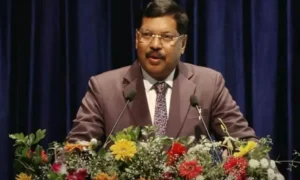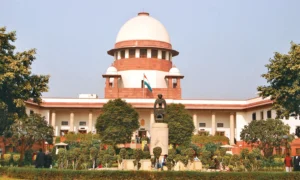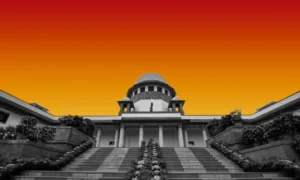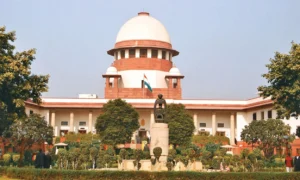
Dr Chetna Garera
Even after the Supreme Court created a National Task Force to ensure the safety of medical professionals, India’s doctors continue to be beaten, threatened, and humiliated within the very institutions where they save lives. “We enter hospitals to save lives, not to fear for our own,” murmured a young Delhi resident doctor after being assaulted in the emergency ward. That one line captures the despair of a profession increasingly defined not by healing but by danger.
In August 2024, the Supreme Court of India stepped in to confront a crisis that had long simmered beneath the surface of Indian healthcare. It established the National Task Force for the Safety of Doctors and Healthcare Workers, directing it to devise ways to protect those at the frontlines of medicine. The move came after a succession of shocking episodes: the brutal rape and murder of a trainee doctor in Kolkata, attacks on resident doctors in Delhi and Uttar Pradesh, and violent outbursts inside hospital corridors that turned places of healing into sites of chaos.
The Court’s intervention ignited cautious hope among medical professionals. Many believed the task force would lead to binding reforms, uniform security guidelines, and stronger laws. Yet, a year later, that optimism has faded. India’s hospitals remain volatile spaces where frustration, grief, and miscommunication regularly erupt into aggression. The Supreme Court’s promise of safety now echoes as an unanswered question.
In recent months, the pattern has only grown more disturbing. In Jalgaon, a resident doctor named Dr Mohit Gadiya was beaten so severely by patient attendants that his eardrum ruptured. In Delhi’s Ram Manohar Lohia Hospital, another doctor was attacked while drawing a blood sample. In Kerala’s Kozhikode district, Dr Vipin PT was assaulted with a machete by the father of a nine-year-old girl who had died from a rare infection. The father, convinced his daughter’s death was due to medical negligence, struck out in blind rage. These attacks—separated by states but united in pattern—illustrate that the safety of doctors has barely improved since the task force’s creation.
The Limits of a Task Force
The task force was never meant to wield executive power. It was designed to study the problem and make recommendations to governments. That distinction, though seemingly technical, proved fatal to its impact. Without enforcement powers, it became yet another committee producing papers instead of protection.
A senior health-law expert who had contributed to its consultations summed it up sharply: “We excel at writing reports but fail at implementing them.” While the task force may have produced drafts and frameworks, the absence of deadlines, state cooperation, and funding left its proposals toothless. India’s hospitals, meanwhile, continued to run on overburdened systems—too few doctors, too many patients, and almost no security planning.
Even in states that had already enacted “Medical Protection Acts,” such as Maharashtra and West Bengal, implementation was erratic. First Information Reports were often delayed, investigations stalled, and prosecutions fizzled out. The attackers, frequently released within hours, returned home to sympathy rather than shame. The result is an environment of impunity where assaulting a doctor carries little real consequence.
A Systemic Collapse of Safety
The persistence of these attacks reveals deeper structural failures that no single committee can fix. The most glaring is the absence of a clear legal framework. India still lacks a permanent central law defining violence against healthcare professionals as a serious, non-bailable offence. The temporary safeguard under the Epidemic Diseases (Amendment) Act, 2020 expired with the pandemic. Since then, doctors’ safety has been left to the patchwork of state laws and the general provisions of the Indian Penal Code—sections like 323 (voluntarily causing hurt) or 506 (criminal intimidation). These provisions are bailable, lenient, and ill-suited for the kind of collective aggression doctors face.
Law enforcement too is inconsistent. Many police officers treat hospital assaults as unfortunate but understandable reactions of grieving families. Delayed FIRs and weak investigations tell offenders that their actions will likely go unpunished. The message is devastating: violence inside hospitals is seen not as a crime, but as a cathartic outburst.
Equally troubling is the chaotic infrastructure within most public hospitals. Overcrowded waiting areas, insufficient security personnel, and lack of proper crowd management turn emergency rooms into pressure chambers. One overworked doctor juggling dozens of patients becomes the lightning rod for collective frustration. A single death or procedural delay can quickly ignite mob fury.
At the heart of this crisis also lies a growing trust deficit. Medicine is inherently uncertain; even the best doctors cannot guarantee outcomes. But in a climate of social media rumours, sensationalist reporting, and a lack of transparent communication between hospitals and families, any unfavourable outcome is interpreted as negligence or indifference. This erosion of faith transforms grief into aggression. As Dr Meera Sharma, an anaesthetist from Mumbai who was assaulted in 2023, put it, “When faith collapses, fear takes its place—and fear often lashes out.”
Fear Among the White Coats
The psychological burden this violence imposes on healthcare professionals is immense. Young resident doctors—particularly women—report symptoms of anxiety and post-traumatic stress after witnessing or experiencing attacks. Many avoid emergency postings or night shifts altogether. In small towns, private practitioners close clinics early to avoid potential mobs. Behind the statistics lies a quieter crisis: a generation of doctors is learning to practise medicine defensively, with fear rather than focus.
The damage extends beyond individual doctors. Hospitals that have witnessed repeated assaults often curtail services or reduce emergency availability. Patient care suffers under an atmosphere of tension. Safety, it turns out, is not an optional comfort; it is the foundation of effective healing.
A Task Force Without Teeth
The National Task Force was expected to design a national framework, but a year later, there is little evidence of tangible progress. No comprehensive report has been made public, and no time-bound implementation schedule has been issued. Health being a state subject further complicates matters—the Centre can suggest, but cannot compel. Without strong inter-governmental coordination, the task force’s work remains advisory, not actionable. What should have been a catalyst for reform has instead become another administrative footnote.
What Must Change
If India genuinely intends to protect its doctors, it must move from sympathy to structure—from mourning after every tragedy to preventing the next one. The solution lies not in forming new committees, but in creating a binding, enforceable system that treats hospital violence as an attack on the state itself.
India urgently needs a Central Healthcare Protection Law that criminalizes violence against medical professionals with clarity and severity. Such a statute must define offences broadly, covering not only physical assault but also intimidation, verbal abuse, and damage to hospital property. It must make these crimes non-bailable, prescribe minimum sentences, and ensure mandatory compensation to the victims—recoverable from offenders. The law should also provide for fast-track courts so that cases do not languish for years.
But legislation alone will not suffice. Hospitals need physical and procedural safeguards embedded into their architecture. Every tertiary hospital should have round-the-clock surveillance, controlled entry points, panic alarms connected to local police stations, and trained security personnel capable of handling crises without escalation. Proper lighting, clear exit routes, and visible signage are basic requirements that remain unmet in many facilities.
Perhaps most crucially, there must be regular safety inspections by independent experts—preferably biannually—to identify blind spots, under-construction areas, and isolated corridors vulnerable to misconduct or crime. These inspections should not be symbolic; they must result in actionable reports shared with both hospital management and local health authorities. Routine night-shift drills and vulnerability audits would ensure that every staff member knows exactly how to call for help when threatened.
As one security consultant at AIIMS observed, “Safety cannot be reactive; it must be engineered into the design of care.”
Supporting the Healers
Doctors who face violence also need institutional support that goes beyond words of solidarity. Hospitals should immediately provide legal assistance, paid medical leave, and trauma counselling for affected staff. Insurance coverage for injuries and clear indemnity for doctors who follow standard procedures are essential. These measures would reassure young practitioners that the system will stand beside them when things go wrong, rather than abandoning them to bureaucracy and blame.
Judicial oversight could further strengthen accountability. The Supreme Court should direct the NTF to publish its findings and require quarterly compliance reports from state governments. Chief secretaries must be held personally responsible for delays or inaction. Without judicial pressure, policy inertia will persist.
Public awareness too plays a decisive role. Violence against doctors often stems from misinformation and unrealistic expectations. A sustained national campaign—perhaps titled “Respect Those Who Heal”—could educate citizens about the complexities of treatment, the limits of medicine, and the penalties for assaulting medical workers. Media houses must act with restraint when reporting alleged cases of negligence; premature blame can inflame public anger and jeopardize lives. Social media platforms, meanwhile, must cooperate in flagging and removing rumours that could provoke violence.
Finally, the medical fraternity itself can help bridge the divide. Training doctors in communication and empathy—skills often sidelined in medical education—can prevent many misunderstandings. Structured patient briefings, transparent updates, and compassionate explanations during crises can diffuse anger before it explodes. Sometimes, saving a situation begins with simply being heard.
Towards a Culture of Accountability
For real progress, India must also begin to count what it cannot yet see. A centralized national database of attacks on healthcare workers—recording FIRs, arrests, convictions, and outcomes—would bring visibility to a problem long buried in anecdotes. Regular public reports comparing state performance could generate the pressure needed for reform. Independent oversight committees, including representatives from the medical, legal, and civil sectors, could audit hospitals and publish annual “Safety Index” scores, naming and shaming negligent administrations.
A Call to Conscience
India’s healthcare system is held together by exhausted professionals who continue to show up despite inadequate pay, scarce resources, and growing hostility. Every assault on them chips away at the moral spine of a nation that depends on their dedication. Each time a doctor is attacked, it sends a cruel message to those still in training: your safety doesn’t matter.
“We have become casualties in the very war we fight—to save lives,” a protesting resident in Mumbai recently lamented.
The Supreme Court’s task force was a gesture of concern. But concern, without conviction, changes nothing. What India needs now is enforcement, not empathy alone—a system where the assault of a doctor triggers swift police action, strict prosecution, and certain punishment.
If the country truly values its healers, it must prove it through law and action. Only when violence invites real consequences will hospitals become sanctuaries once more. Until then, the white coat will remain both a badge of honour—and a target.
—Dr Chetna Garera is a second-year student of Swami Dayal Bhatnagar Law College, CCS University, Meerut
📰 Crime Today News is proudly sponsored by DRYFRUIT & CO – A Brand by eFabby Global LLC
Design & Developed by Yes Mom Hosting






